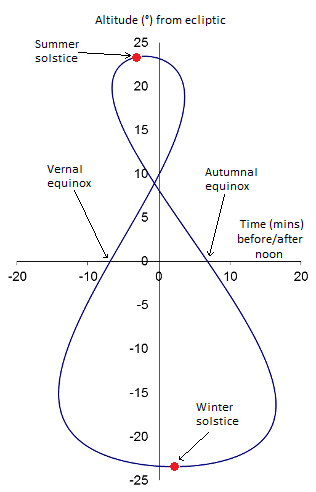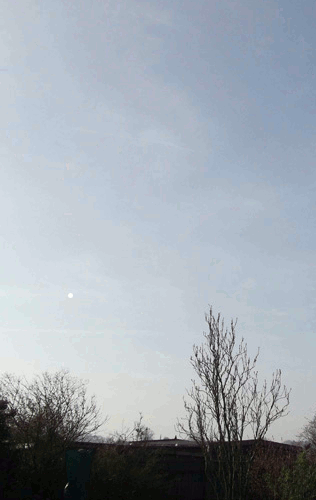

Orwell Astronomical Society (Ipswich)
The Analemma, 18 February 2014 - 18 February 2015


Point a camera due south, fix it in position, and take a picture of the Sun at midday, every day for a year. Should you expect a vertical line of overlapping suns on the meridian, ranging from 23.5° above to 23.5° below the position of the celestial equator?
Actually... no! Sometimes the Sun will be slightly behind its average position and sometimes ahead. The net effect is to produce a pattern of a slender, slightly-bowed figure-of-eight, known as the analemma.
The offset of the Sun from its mean position is described by the equation of time (EoT), formally the correction that must be applied to apparent solar time to obtain mean solar time. Apparent solar time is the time shown by the real Sun, for example via a sundial, and is non-uniform. Mean solar time is a uniform time defined by a fictitious Sun moving at the average solar rate. The EoT may be observed by comparing clock time with time shown by a sundial.
Two processes contribute to the EoT. The first is the effect of the Earth’s orbit, which is elliptical with the Sun at one focus. When the Earth is at perihelion (closest to the Sun, in January), the sundial reads true; however, the Earth is moving at its greatest orbital angular velocity and, as a result, successive meridian crossings of the Sun (observed from a given location) require the planet to rotate further than average on its axis, causing the sundial to run increasingly slow. The effect is cumulative and sundial time is at its slowest in early April. However, as the Earth moves from perihelion towards aphelion (furthest from the Sun, in early July), its orbital velocity decreases and successive meridian crossings ultimately require the planet to rotate less than average on its axis. Thus the sundial begins to catch up until, at aphelion, it reads true and, after aphelion, reads increasingly fast. In early October, sundial time is at its fastest. However, the Earth's orbital angular velocity increases as the planet approaches perihelion once more and this causes sundial time to run increasingly slow until, at perihelion, the sundial once more reads true. The cycle repeats annually. This process accounts for a variation of almost ±8 minutes between sundial time and clock time.
The second process results from the fact that the Sun's motion is along the ecliptic rather than the celestial equator. The inclination between the two planes is 23.5°. Around the winter and summer solstices, the Sun's motion along the ecliptic is approximately parallel to the celestial equator. However, around the vernal and autumnal equinoxes, when the path of the Sun is at its greatest inclination to the celestial equator, the Sun's net daily motion along the latter is reduced. The effect induces a variation in the EoT with a period of half a year, of approximately ±10 minutes, with the sundial at its fastest in May and November and slowest in February and August.
The net effect of the two processes is cumulative, with the angular displacement between perihelion and solstice defining the relative phases of the components. Perihelion occurs between 13 and 14 days after the winter solstice. The figure to the top right shows a theoretical calculation of the net effect. For more information, see Wikipedia.
Because there is not an exact number of days in a year, the times of solstices, equinoxes and perihelion will generally be about six hours later in successive years, or about 18 hours earlier if the most recent February had 29 days. When photographing the analemma, if exposures are taken beyond the duration of a year, images of the Sun will appear about a quarter of a day behind their counterpart 12 months earlier.
The animation to the right shows the solar analemma, illustrating the path followed by the Sun from 18 February 2014 - 18 February 2015, seen from the windowsill of a house just north of Ipswich. (The location is about 1.2° east, with the Sun approximately five minutes ahead of Greenwich.) It was taken by a webcam pointing due south, triggered automatically by a PC to take a snapshot at 12 o’clock noon civil time (GMT) every day. Owing to the lack of dynamic response of the webcam, the lens has been covered by a miscellany of filters. Each image of the Sun is overlaid on an unfiltered picture of the sky taken at the same location. Gaps in the sequence are a result of the Sun being obscured by cloud. Despite the gaps, the end result is very pleasing!
Images below show the webcam in position looking out of a south-east facing window, and its protective box.
Alan Smith, Joe Startin